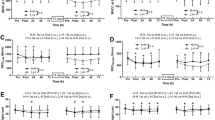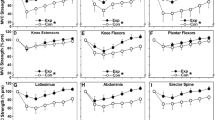Abstract
This study examined the effects of cold therapy (COLD) on recovery of voluntary and evoked contractile properties following high-intensity, muscle-damaging and fatiguing exercise. Ten resistance-trained males performed 6 × 25 maximal concentric/eccentric muscle contractions of the dominant knee extensors (KE) followed by a 20-min recovery (COLD v control) in a randomized cross-over design. Voluntary and evoked neuromuscular properties of the right KE, ratings of perceived muscle soreness (MS) and pain, and blood markers for muscle damage were measured pre- and post-exercise, and immediately post-recovery, 2, 24 and 48-h post-recovery. Exercise resulted in decrements in voluntary and evoked torque, increased MS and elevated muscle damage markers (p < 0.05). Measures of maximal voluntary contraction (MVC) or voluntary activation (VA) were not significantly enhanced by COLD (p > 0.05). Activation of right KE decreased post-exercise with increased activation of biceps femoris (BF) (p < 0.05). However, no significant differences were evident between conditions of activation of KE and hamstrings at any time point (p > 0.05). No significant differences were observed between conditions for creatine kinase or asparate aminotransferase (p > 0.05). However, perceptual ratings of pain were significantly (p < 0.05) lower following COLD compared to control. In conclusion, following damage to the contractile apparatus, COLD did not significantly hasten the recovery of peripheral contractile trauma. Despite no beneficial effect of COLD on recovery of MVC, perceptions of pain were reduced following COLD.





Similar content being viewed by others
References
Allen GM, Gandevia SC, McKenzie DK (1995) Reliability of measurements of muscle strength and voluntary activation using twitch interpolation. Muscle Nerve 18:593–600
Bailey DM, Erith SJ, Griffin PJ, Dowson A, Brewer DS, Gant N, Williams C (2007) Influence of cold-water immersion on indices of muscle damage following prolonged intermittent shuttle running. J Sports Sci 25:1163–1170
Behm DG, Baker KM, Kelland R, Lomond J (2001) The effect of muscle damage on strength and fatigue deficits. J Strength Cond Res 15:255–263
Bigland-Ritchie B, Furbush F, Woods JJ (1986) Fatigue of intermittent submaximal voluntary contractions: central and peripheral factors. J Appl Physiol 61:421–429
Brown SJ, Child RB, Day SH, Donnelly AE (1997) Indices of skeletal muscle damage and connective tissue breakdown following eccentric muscle contractions. Eur J Appl Physiol Occup Physiol 75:369–374
Cheung K, Hume P, Maxwell L (2003) Delayed onset muscle soreness: treatment strategies and performance factors. Sports Med 33:145–164
Cram JR, Kasman GS (1998) Introduction to surface electromyography. Aspen Publishers, Gaithersburg
Ebbeling CB, Clarkson PM (1989) Exercise-induced muscle damage and adaptation. Sports Med 7:207–234
Endoh T, Nakajima T, Sakamoto M, Komiyama T (2005) Effects of muscle damage induced by eccentric exercise on muscle fatigue. Med Sci Sports Exerc 37:1151–1156
Eston R, Peters D (1999) Effects of cold water immersion on the symptoms of exercise-induced muscle damage. J Sports Sci 17:231–238
Goodall S, Howatson G (2008) The effects of multiple cold water immersions on indices of muscle damage. J Sports Sci Med 7:235–241
Halson S, Quod MJ, Martin DT, Gardner AS, Ebert TR, Laursen PB (2008) Physiological responses to cold water immersion following cycling in the heat. Int J Sports Physiol Perform 3:331–346
Howatson G, Gaze D, van Someren KA (2005) The efficacy of ice massage in the treatment of exercise-induced muscle damage. Scand J Med Sci Sports 15:416–422
Ingram J, Dawson B, Goodman C, Wallman K, Beilby J (2009) Effect of water immersion methods on post-exercise recovery from simulated team sport exercise. J Sci Med Sport 12:417–421
Isabell WK, Durrant E, Myrer W, Anderson S (1992) The effects of ice massage, ice massage with exercise and exercise on the prevention and treatment of delayed onset of muscle soreness. J Athl Train 27:208–217
Jakeman J, Macrae R, Eston R (2009) A single 10-min bout of cold-water immersion therapy after strenuous plyometric exercise has no beneficial effect on recovery from the symptoms of exercise-induced muscle damage. Ergonomics 52:456–460
McHugh MP, Connolly DAJ, Eston RG, Gleim GW (1999) Exercise-induced muscle damage and potential mechanisms for the repeated bout effect. Sports Med 27:157–170
Meeusen R, Lievens P (1986) The use of cryotherapy in sports injuries. Sports Med 3:398–414
Nosaka K, Sakamoto K, Newton M, Sacco P (2001) How long does the protective effect on eccentric exercise-induced muscle damage last? Med Sci Sports Exerc 33:1490–1495
Paddon-Jones DJ, Quigley BM (1997) Effect of cryotherapy on muscle soreness and strength following eccentric exercise. Int J Sports Med 18:588–593
Pasquet B, Carpentier A, Duchateau J et al (2000) Muscle fatigue during concentric and eccentric contractions. Muscle Nerve 23:1727–1735
Peiffer JJ, Abbiss CR, Nosaka K, Peake JM, Laursen PB (2009) Effect of cold water immersion after exercise in the heat on muscle function, body temperatures and vessel diameter. J Sci Med Sports 12:91–96
Prasartwuth O, Taylor J, Gandevia S (2005) Maximal force, voluntary activation and muscle soreness after eccentric damage to human elbow flexor muscles. J Physiol 567:337
Prasartwuth O, Allen T, Butler J, Gandevia S, Taylor J (2006) Length dependent changes in voluntary activation, maximum voluntary torque and twitch responses after eccentric damage in humans. J Physiol 571:243–252
Psek JA, Cafarelli E (1993) Behavior of coactive muscles during fatigue. J Appl Physiol 74:170–175
Rothmuller C, Cafarelli E (1995) Effect of vibration on antagonist muscle coactivation during progressive fatigue in humans. J Physiol 435:857–864
Sayers SP, Peters BT, Knight CA, Urso ML, Parkington J, Clarkson PM (2003) Short-term immobilization after eccentric exercise Part I: Contractile properties. Med Sci Sports Exerc 35:753–761
Sellwood KL, Brukner P, Williams D, Nicol A, Hinman R (2007) Ice-water immersion and delayed-onset muscle soreness: a randomised controlled trial. Br J Sports Med 41:392–397
Vaile J, Halson S, Gill N, Dawson B (2008a) Effect of cold water immersion on repeat cycling performance and thermoregulation in the heat. J Sports Sci 26:431–440
Vaile J, Halson S, Gill N, Dawson B (2008b) Effect of hydrotherapy on the signs and symptoms of delayed onset muscle soreness. Eur J Appl Physiol 102:447–455
Vaile J, O’Hagan C, Stefanovic B, Walker M, Gill N, Askew CD (2010) Effect of cold water immersion on repeated cycling performance and limb blood flow. Br J Sports Med. doi:10.1136/bjsm.2009.067272
Wilcock IM, Cronin JB, Hing WA (2006) Physiological response to water immersion: A method for sport recovery? Sports Med 36:747–765
Wilder MR, Cannon J (2009) Effect of age on muscle activation and twitch properties during static and dynamic actions. Muscle Nerve 39:683–691
Yanagisawa O, Niitsu M, Yoshioka H, Goto K, Kudo H, Itai Y (2003) The use of magnetic resonance imaging to evaluate the effects of cooling on skeletal muscle after strenuous exercise. Eur J Appl Physiol 89:53–62
Acknowledgments
The authors would like to thank the subjects for their participation and enthusiasm. In addition, the authors would like to acknowledge all of the staff at Bathurst Pathology for their assistance with the blood analysis and Gary McKenzie at SPAN for his help with EMG analysis. The authors declare that they have no conflict of interest.
Author information
Authors and Affiliations
Corresponding author
Additional information
Communicated by Toshio Moritani.
Rights and permissions
About this article
Cite this article
Pointon, M., Duffield, R., Cannon, J. et al. Cold application for neuromuscular recovery following intense lower-body exercise. Eur J Appl Physiol 111, 2977–2986 (2011). https://doi.org/10.1007/s00421-011-1924-1
Received:
Accepted:
Published:
Issue Date:
DOI: https://doi.org/10.1007/s00421-011-1924-1




